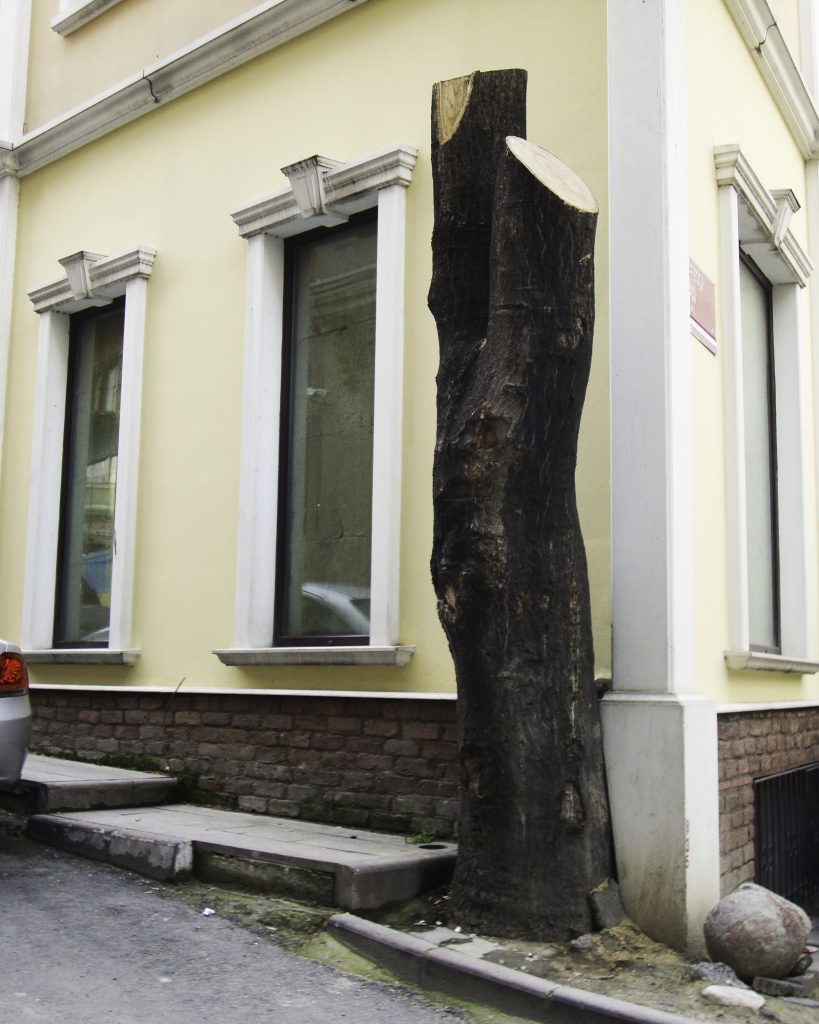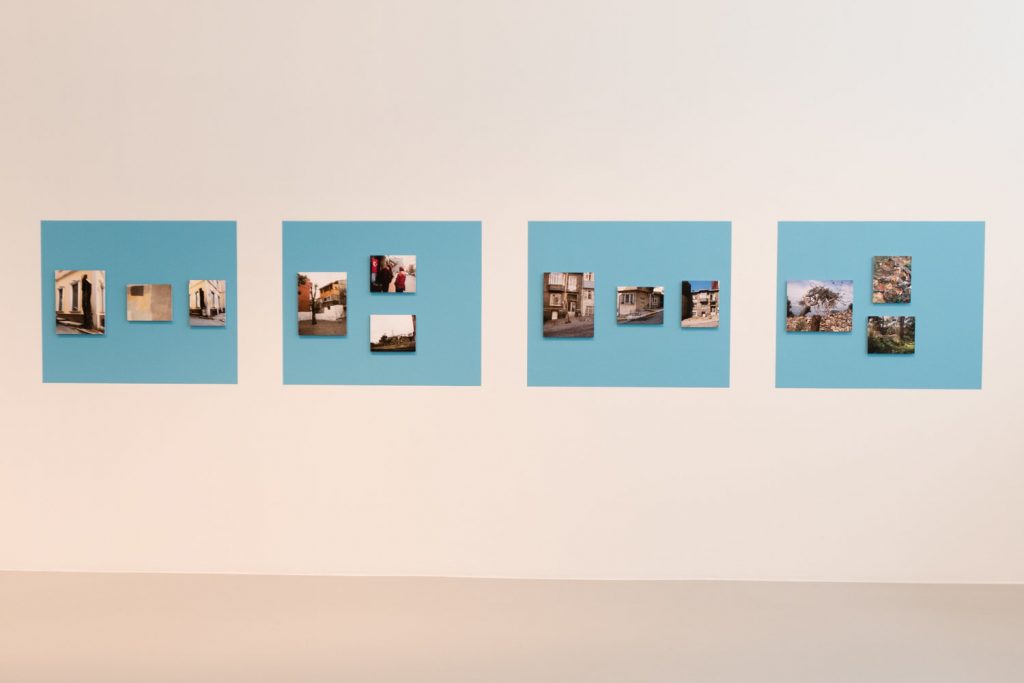
Image Credit: roberley bell, “Still Visible After Gezi”
As part of the release of the hardcover release of my book, Walking as Artistic Practice (softcover comes out in April!), I’m going to be publishing some brief interviews with the various artists, authors, researchers, creatives, collectives, and platforms whose art practice, written material, or other works I cite and mention.
My 16th interview in this series is with Roberley Bell whose practice draws on the world around her, inspired by place and time. She is also the recipient of numerous fellowships including a Fulbright to Turkey. Still Visible After Gezi and the accompanying monograph Do You Know This Tree? Published by Visual Studies Press documents a walk in Istanbul spanning five years. Bell creates personal walking projects and leads walking workshops internationally.
EM: First, thank you for chatting with me about your work Still Visible After Gezi (2015). I cite this work in chapter two (Analyzing Walking Works) in the subsection “Photography.” How would you describe this work for people who might not be familiar with it?
RB: The images included in the installation Still Visible After Gezi and the subsequent monograph Do you know this Tree? Began in 2010, while I was living in Istanbul. I learn a city by walking and in 2010, on my daily walks meandering the city streets on a way to a friend’s house, or simply for baklava, I began to notice and started photographing certain trees. They were not iconic symbols of the beauty of nature, but rather trees that appeared compromised-yet protected, nurtured. These are trees that elsewhere might be considered ugly, or located in inconvenient places, and would just be cut down. In Istanbul however, somebody was really caring for them. The trees of Istanbul, for me, became a stand in for the humanity of the city. They are not the representation of natural beauty. Conversely these trees represent the beauty of humanity through their desire to preserve and protect nature within the unstable social condition of the urban environment.
On May 21, 2013, demonstrations in the city of Istanbul began in Gezi park, which is a small, not particularly lovely concrete park with some trees in the center of the city. I often walked through Gezi and there was something about the demonstrations that hit home for me. Though the demonstrations were initially sparked because the government wanted to bulldoze the park and build a mall, it really was not about the trees. Yes, the first night it was to save the trees, and maybe even the second and third day, but the demonstrations of Gezi Park became a demonstration against the government of Turkey. In 2015, I returned to Istanbul. I wanted to try to find the trees I had photographed in 2010. The trees had become important to me and I knew the process of seeking them out would reveal something – I just wasn’t sure what that would become. I wanted to see If working from memory, I could relocate the trees. The experience resulted in the monograph Do you know this tree? published by Visual Studies Workshop 2017 and the installation Still Visible after Gezi included in the traveling exhibition Wanderlust 2017.

Image Credit: roberley bell, “Still Visible After Gezi”
EM: What are your thoughts on walking as artistic practice?
RB: My practice of walking takes on many forms and is yet only one thread of my ongoing creative studio practice.
I employ the physical act of walking and the documentary process of sensory coding- mapping as a tool for understanding space and place. The city reveals herself gradually as I walk. Learning from the city, I am exploring the issues of sensory spatial engagement with place, using the city as a mode for research in and of itself. Through the simple performative act of walking, I engage in discovery as a means to understand something not yet known about a place. I connect to the world through my senses – what I see, what I hear, what the air tastes like. Walking heightens all of our senses whilst slowing down the pace of sensing the city. These sensory codes make places meaningful.
I am interested in the richness of the diverse representation of the city and the overlapping of space and place through the personal and collective narratives. How do we each see something different, what is our memory of a place and how do we record this rich history to develop a more inclusive use of public space as social space? My process of sensory observational walking provides an experimental method for approaching the investigation of the city. Whether it is our own city or an unfamiliar one, whether walking with a predetermined destination or following sounds, smells, paths, people and shadows we are introduced to a place. Through the act of walking experiences of place are absorbed on their most personal level, feet first, step by step.
My walks begin as a personal quest, a form of investigation, sometimes with a defined strategy other times not. The relationship between the idea that I have for the walk ,the physical walk itself and how I choose to bring the evidence of the walk to fruition is always in flux. Ideas often change once on the ground. The form that is the evidence of my walk emerges from my process on the ground. I have completed walks in numerous cities, including Istanbul, Salzburg, Sharjah ,Paris, Holyoke amongst others. The outcomes were not predetermined at the onset. Each walk dictated its own form. The results have been books, photo documentation, handwritten letters, and drawings. I select the means that best capture the essences of the place, those experiences and perceptions that I gather along the way. Alongside my personal walking projects I am engaged in walking with others, leading workshops worldwide.

Image Credit: roberley bell, image of the stacks of maps from Reading Poems: 26 walks in Malmo
EM: Can you tell us about any upcoming or recent projects you are excited about?
RB: My current project, Reading Poems: 26 walks in Malmö, began with the straightforward premise of walking the city each day. To explore the edges, to walk as far as I desire in a day and to become more and more familiar with Malmö as a place over time.
My daily routine began with studying my well worn street map of Malmö seeking a location to further explore, a neighborhood, a specific park ,a view to the sea, something I had been told about. Then I would move out leaving from the front door, the only constant over 26 walks was the point of departure. I would begin without a specific path in mind. Just the idea of where I was headed, not how I would walk there. I would allow encounters, something unexpected, or the desire to take a seat with a coffee along my way to direct the path.
Acknowledging my surroundings and letting go of what might be the obvious way to a destination I walk nomadically. I would pause to reflect, to write, to draw here or there and then re navigate my path and move onwards. The places where I stop , things that I encounter do not form landmarks on my hand drawn maps, they are reflected in the linear gesture of the map because they have after all dictated my path.
Reading Poems: 26 walks in Malmö, takes the form of 26 hand drawn maps, along with a hand drawn street map and image lexicon. My hand drawn maps are the mark of my walk as a linear thread unraveling through the city. Drawn nightly while still fresh in my mind they also aided in planning the next day’s walk.
The maps are drawn on vellum; the translucency of the paper allows each day to be seen through the next. The stack of days, one atop another form a network that is Malmö. The constant a red house , my only landmark noted on the maps. It is my departure point, the doorway of my apartment block on Per Wickenbergsgatan. The small red house can only be seen on the most recent map, the one on top as that point is fixed, the daily path is not.
Because each day was its own exercise I had the desire to visualize in fact where I had been . The hand drawn street map is that web of every street in Malmö that I walked over the course of 26 days. Many I walked on innumerable times and intersections I crossed over time and again. This map is not about the distance traveled, it is a way to piece together the many parts of the city like a puzzle becoming whole, that I had explored.
The lexicon began as a way to record each day . My strategy was to have only one image taken at some point on my path. The image is not iconic nor is it a significant landmark it is rather something that captures my attention long enough to photograph it . Each photograph is marked by date and time. Time acknowledges the real time activity of walking as well giving a sense of my distance from one point to another. If it was early in the day I was close to my front door. Later in the day I was somewhere on my path through the city. The images that form the lexicon are my vocabulary of Malmö my personal visual language of place. The images reflect my own interest in the built and natural environment .They are fueled by my wealth of prior associations.
The images in my Malmö lexicon are like concrete poetry; they can be rearranged to create different narratives of Malmö. The exact location of each image is not necessary .The fact they are there is what is important. I would offer to anyone to wander the city letting what they see from the corner of their eye direct them.
Reading Poems: 26 walks in Malmö, will be exhibited at Form/Design Center Malmö, summer 2024.